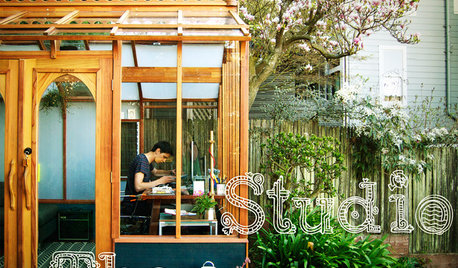Why do greenhouse use diffused light?
meyermike_1micha
16 years ago
Featured Answer
Sort by:Oldest
Comments (9)
saucer
16 years agobihai
16 years agoRelated Discussions
Why I Chose today to open start using my greenhouse
Comments (15)Ohmygosh! I NEVER thought about the effect of sunlight on the placement of the intake vents/exhaust fan thermostat! My new GH is finished, at least to the point of being sealed, except for the frames we will add around the intake vents and exhaust fan and have rather abandonded it for the present, as we hustle to get our fall yard and field work done while the Sun shines, which it hasn't for much of the past month. But we do have electricity into the GH, so even when it turns really cold, we can still work inside of it and one of the questions has been the placement of the thermostats. Now I've been warned about the one for the vents/fan, I'll be sure to mount it in a shaded location, but what about the thermostat for the heater? My best sense tells me it should be mounted by the north facing door at the opposite end of the GH from the heater, because even with the intake vents and exhaust fan closed for the winter, the roof vents will still release excess heat. Yes? No?...See MoreTo diffuse or not to diffuse...
Comments (1)I built a custom greenhouse with polycarbonate, and haven't regretted it once. I love my greenhouse. I used corrugated polycarbonate, and believe plenty of light comes through. No matter whether you use 4mm twin wall or 8 mm twin wall or solid corrugated, you're still going to have heat loss. It's the nature of a greenhouse to lose heat, and if you want the inside to be at a certain temperature, you will need to consider a source of heat....See MoreGreenhouse question: to diffuse or not to diffuse?
Comments (9)Well, I am not on the East Coast, but in the Midwest, heart of Illinois and I use a Rion, have had it for a few years now & so far, so good as far as lighting. Yes any greenhouse will cost to heat, but least yours will be rather small compared to many. Here is a link that might be useful: Here is mine all wrapped up for winter...See MoreWhat conditions do you use for Rex Begonias in a greenhouse?
Comments (7)Russ, Not sure who you are asking but I am in the Atlanta area. I don't have a greenhouse since I moved - just use my basement for winter care - run 86 or a few more shop lights and could use a lot more for optimum growth. My old greenhouse did have its issues as you mentioned - had roof vents but only two out of four worked. In summer I moved everything outdoors except cactus and succulents as they basked in the heat and drier conditions. The greenhouses I showed above are commercial grade and I guess they have the roof painted with something to lessen the UV rays or maybe some kind of shade cloth? Never gave it much thought since it is bright and very HUMID! They grew a lot of plants in hanging baskets to grow more on the benches below. One of the prop rooms showing fan at the end. The only time my wife accompanied me to a begonia buying trip for our local branch's annual sale. The mother plants grow to enormous sizes due to the bright light of Orlando. A mother plant of Judy Cook that I bought filled half my back seat in my truck. A plant for sale more plants for sale - biggest size they grow - 8 inches. A row of commercial greenhouses before we go into the sauna......See Moretapla (mid-Michigan, USDA z5b-6a)
16 years agobihai
16 years agomeyermike_1micha
16 years agotapla (mid-Michigan, USDA z5b-6a)
16 years agomeyermike_1micha
16 years agomeyermike_1micha
16 years ago
Related Stories

DECORATING GUIDESGo for a Greenhouse Effect With an Exotic Conservatory
Cultivate a rarified hothouse feel with or without all-glass walls; these inspiration photos and product picks show you how
Full Story
OUTBUILDINGSRoom of the Day: An Old Shed Becomes a Spa and Greenhouse
A garden-loving couple create the perfect place to have a soak and putter with their plants year-round
Full Story
OUTBUILDINGSStudio Solution: A Kit Greenhouse Becomes a Creative Private Office
See how an inventive work-from-home designer made an office from a greenhouse, for some inspired thinking in the backyard
Full Story
GREENHOUSESGreenhouses Bring Gardens in From the Cold
Get a jump start on summer plantings even if spring chills linger with a greenhouse or cold frames in your backyard
Full Story
GARDENING AND LANDSCAPINGSee a Family Greenhouse Grown From Scraps
Can-do resourcefulness and less than $400 lead to a new 8- by 8-foot home for plants on a Tennessee family's property
Full Story
GREENHOUSESA Greenhouse Rises From Texas Tornado Wreckage
Barn damage became a blessing in disguise for a thrifty, creative couple with a hankering for more greenery
Full Story
Houzz Call: Show Us Your Greenhouse
Submit a photo of your greenhouse and share what's growing!
Full Story
LANDSCAPE DESIGNA Luxury Greenhouse Lures Manhattanites to the Country
Industrial meets rustic in this stunning new structure for living and entertaining in rural Pennsylvania
Full Story

ARCHITECTURESee Light Play in 14 Homes From Paris to Texas
Whether their screens let the light dance or their opaque windows diffuse it, these homes are beacons of great design
Full Story






saucer